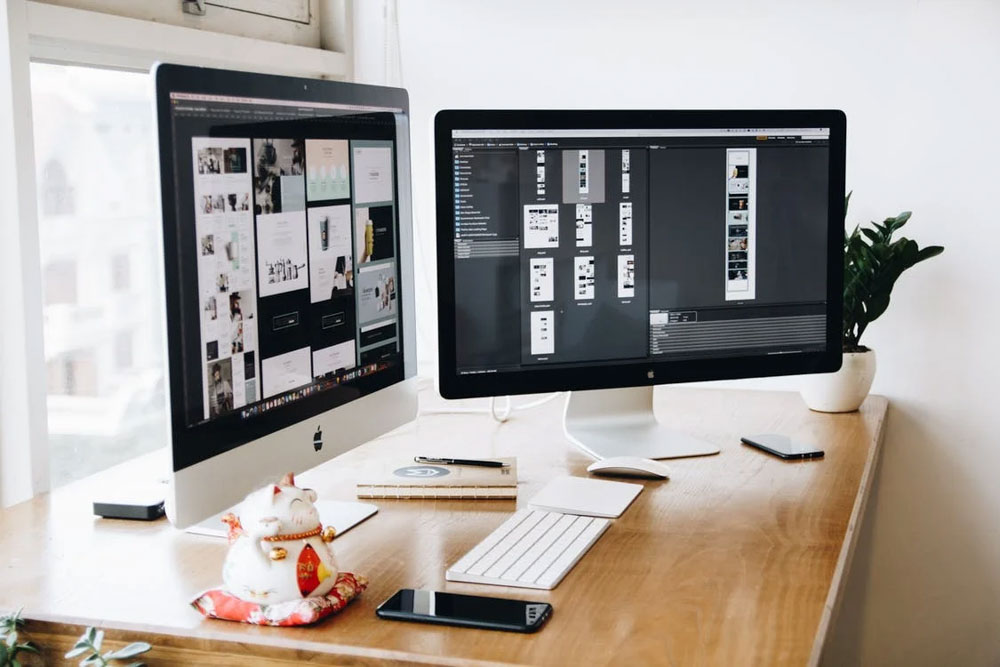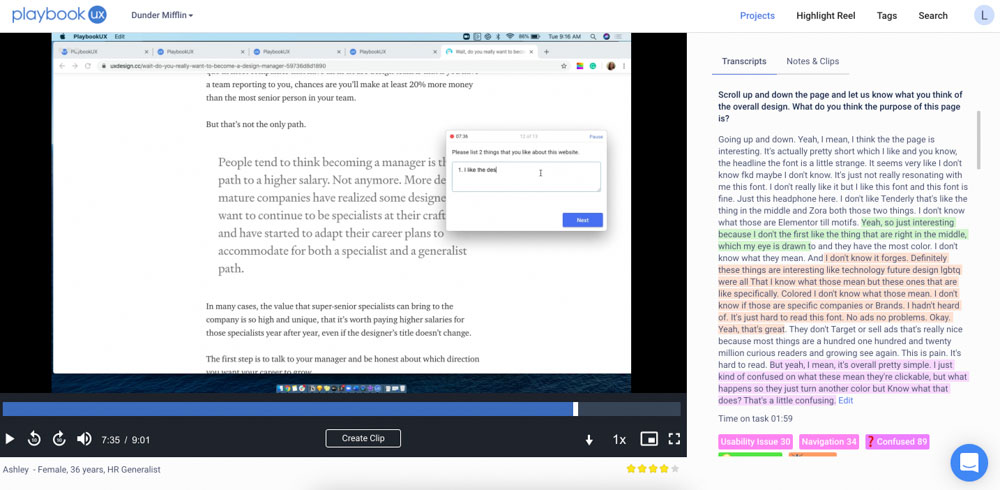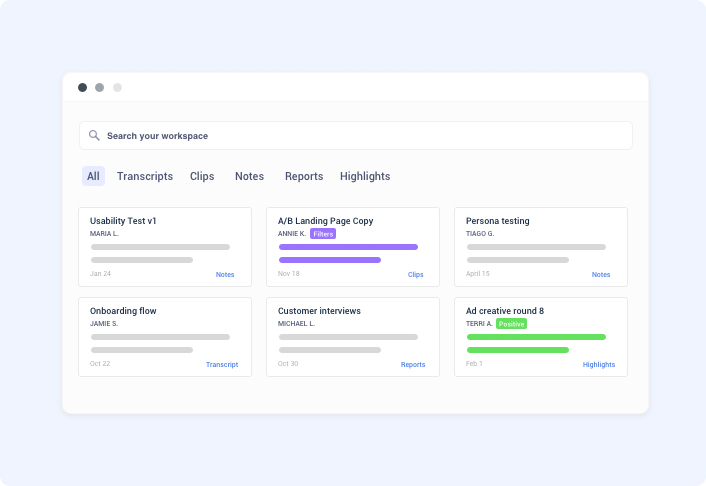How to Improve Your Content Design With User Testing Tools

Image source: Pexels
Content design is a crucial differentiator for brands in almost every industry. However, designing engaging, informative, and compelling content can be challenging.
Many product teams find it difficult to know what users prefer or expect from their content. Given this challenge, user testing tools are becoming an essential part of the content design process for many brands.
These tools help you discover what users think about your content by observing them as they complete tasks and taking notes during the session. This way, you can identify issues with your content and make informed decisions moving forward.
PlaybookUX, our video-based user testing platform, helps you conduct different types of user tests to gather actionable insights regarding your content design effectiveness.
You can watch videos of users interacting with your product and get video-based feedback. It helps you understand their motivations, thoughts, and emotions so you can optimize your content accordingly.
PlaybookUX helps you automate tedious testing tasks that waste your time and find data faster with a robust search feature. It keeps your crucial testing information in one place and lets you share it with your team members, improving your product development teams’ collaboration. To try out PlaybookUX features, you can create your free account right now.
In today’s article, we will share all the essential information about the content design and explain how to improve it using usability testing tools. Continue reading to learn more.
What is content design?

Image source: Pexels
Content design is the process of creating and shaping the content for your product. It is what people see when they land on your site, bringing them back for more. Content types include text, images, videos, audio, and interactive elements.
Content design is a broad field, but some fundamental principles are common across all types of content:
- It needs to be relevant to your target audience
- It should be accessible and easy to use
- It should be clear, concise, and accurate
Without high-quality and engaging content, you risk losing visitors. Let’s explain a few more reasons why content design is essential for your product’s success.
Why is content design essential for the optimal user experience?
The internet is no longer new – most people understand how to use it and they consume an incredible amount of information daily. The number of available websites is so immense that users quickly dismiss websites they find challenging to navigate.
Nowadays, you can’t simply publish the content on your site and hope people will like it. Providing them with an optimal experience is essential, or they won’t feel engaged and return to your website. It also means they won’t buy your products and services, resulting in lower revenue for your business.
Content design is a crucial part of the UX process, and many benefits come with well-designed content. It makes your website more usable and engaging. Creating an optimal user experience can also increase your website conversion rate, engagement rates, and overall traffic.
It’s essential to think about what users want and need. You need to structure the content in a way that makes sense for them. You can also think about what makes great content and ensure your product has something similar to guide users along their journey.
The difference between the content strategy and content design
The main difference between content design and content strategy is their direction: content strategy focuses on creating an overall business plan, while content design focuses on developing individual pieces of content.
The content design includes creating a collection of elements you can use to develop products, such as website layouts, user interface pages, blog posts, videos, and other types of content.
A content strategy is a broader process. The content strategists look at the bigger picture of how the content will be created, distributed, and used to build a brand. Content strategy considers all aspects of the project, from planning to distribution to use, including human resources (people), technology (tools), and finance (resources).
While both processes are critical for effective product development, keeping them separate when working on a project is essential. If not done carefully, confusion and inefficiency can result from their overlap.
What is the role of content designers?

Image source: Pixabay
Content design is an essential step in product development you should conduct at the beginning of the project. Content designers work alongside web developers, copywriters, UX writers, UX designers, graphic designers, and other specialists.
They are responsible for creating visually attractive, valuable, and engaging content that is well-organized, easy to navigate, and optimized for search engines. They also evaluate how the content will look and feel on screen and how it will fit into the overall design of a site or app.
Specific responsibilities of content designers can differ between companies, but in general, they take care of the following:
- planning the creation of assets and objects for the website or solution
- designing readable, accessible, and relevant content
- creating content hierarchy and taking care of proper information architecture
- helping make the UI intuitive and user-friendly
- Implementing the content strategy
- ensuring the content fulfills the needs of both the users and the company
Long story short, it’s an essential role. Without good designers, engaging material, consistent messaging, and solid content marketing, it would be much harder to fulfill your business goals.
What makes a good content designer?
A person working as a content designer needs to have the following skills to do their job properly:
- the ability to write – content design is more than just writing. You should know how to create good microcopy, UX copy, or transactional content
- communication skills – content design isn’t a job you can do by yourself, so well-developed soft skills are a necessity
- empathy – you’ll need to be able to understand the goals and motivations of your target user
- capacity for planning and strategizing – the job requires you to create content plans that outline a vital part of the project
- the ability to analyze data – user testing plays a vital role in content design, and it generates a lot of complex data you can analyze to improve the content design
As you can see, quite a few skills are required to design and create content successfully. Now that you know the basics let’s explore the content design process.
The key elements of a successful content design process

Image source: Pexels
The content design process can be divided into several important steps, and you shouldn’t neglect any of them. Let’s dive into the details.
1. Define audience and goals
It’s pretty obvious but worth mentioning nonetheless. Before you start designing your content, you first need to know who’s the target audience and what you want to accomplish.
Your goals and audience will define the nature of your content more than anything else.
2. Define user scenarios
When you know who will use your product, it’s time to define user scenarios and user journeys. You can create user stories to illustrate how users interact with your solution – what they want to achieve and how precisely they’ll do that.
User stories and journey mapping allow you to create a user-centric product. You can understand your users better and get a glimpse of possible motivations, needs, and challenges they might encounter while using your product.
3. Define content objectives
You’ve defined the general, long-term goals in the first step, but now it’s time to set specific objectives to achieve within a particular period, such as the next month, three months, and so on. Start planning each content piece with these objectives in mind.
4. Create content architecture
At this point, you should know what content units to create and for whom. Now you need to ensure the content is readable and accessible. After all, what’s the point of creating great content if users won’t be able to find it because the website – or even a specific page – looks like a maze?
Consider what kind of information users want to find on your page and how you can provide it quickly. Create a site map and proper labels for your content, and consider layouts for various pages. Take care of metadata and taxonomy.
Finally, make sure to interlink different content pieces together, wherever applicable, so that users can flow seamlessly from one page to another.
5. Use user testing tools to conduct user research
When you have a plan for your content design, validate it with user research – use user testing tools and conduct different tests to check how users react to your ideas.
A user test is an informal way to determine how well a website or app works for your target audience. It involves a group of people who give feedback on how easy to use a website or app is and what they think about the overall experience.
6. Get the right data to support your decisions
User testing tools such as our PlaybookUX allow you to gather feedback to help improve your content design. For example, you can use card sorting and tree testing to evaluate your website’s information architecture, terms, and labels.
Unmoderated tests will highlight bugs and issues – you’ll get videos, notes, highlight reels, etc. You can also conduct interviews to gather new content ideas and get valuable feedback from your users.
Once you conduct the research, you can gather all the feedback to help you make the necessary adjustments and improvements to your content and website.
But first, since user testing can be an essential part of the content design process, let’s take a few steps back and explain this user research method in detail.
What is user testing?
User testing is a method to evaluate how users perceive your solution and how well it works. You can then make the necessary adjustments to improve your product and the overall user experience. User testing is an invaluable mechanism in the content designer’s arsenal.
You can conduct user tests at various stages of the product development process. It’s generally a good idea to start very early – ideally during the design phase. This way, you can use testing to avoid issues instead of fixing ones you already created.
Of course, to get the most out of the user testing, you need to invest in the right tools – a good user testing platform will make finding participants, conducting tests, and analyzing data considerably effortless. Without such a tool, testing the product would be challenging or expensive.
5 ways how user testing tools help you improve the content design
Using user testing tools during the content design process can be very beneficial. Here are some advantages:
- You get the insights you need – you can create your design on based on comprehensive user insights by analyzing user interacting with your content, website, and designs
- You can verify your ideas before launching your product – user testing can help you avoid mistakes that will negatively affect your budget
- Testing can help you find the right words – open card sorting is a great way to find the proper terminology and names for the menus and categorizing information on your website
- User testing helps you find ideas for content – card sorting, tree testing, and user interviews can provide you insights into users’ needs and wants
- You can evaluate your assumptions and content quality – you can use user testing methods to validate whether users like the content you created and if it fulfills their goals
Now you know how user testing can help you. But what testing methods are there, and what are their differences? Let’s answer these questions in the following section.
5 types of user testing methods
There are many different types of user research methods. Here are some examples of studies you can conduct to improve the content design process:
- Unmoderated testing – you can watch users interact with your product allowing you to see how they react and what problems they face
- Moderated user interviews – it’s an excellent method of getting in-depth feedback from your target audience
- Card sorting – designed to improve your information architecture. Card sorts utilize a bottom-up approach: users sort website items into categories, connecting them logically and naturally. Card sorting tests can be open or closed, which means that you can ask people to use pre existing categories or create their own
- Tree tests – conducted to evaluate a planned or existing information structure. You can create a tree that represents your hierarchical navigation menu, with a complete list of all menus and submenus, users complete a set of tasks to perform
You can conduct all these tests very efficiently using PlaybookUX. Let’s discuss how our user research platform helps you improve your product.
How PlaybookUX helps improve your content design

PlaybookUX is a video-based user research platform that allows you to conduct various usability and user tests such as card sorting and tree testing, unmoderated tests, and moderated interviews. It’s a valuable tool that will significantly help the content design process.
You can use PlaybookUX for:
- usability testing
- mobile web and app testing
- evaluating marketing messages and creative
- prototype testing
- concept testing
- identifying your target audience
Depending on the test, you can watch videos of participants using your solution or communicate with them directly to get more details and ask whatever follow-up questions you want.
PlaybookUX makes it easy to create notes, transcripts, and highlights. Usability tests via PlaybookUX help you understand your users better and give you a way to validate ideas, which is very useful for content design.

You can also use our platform as a user research repository. PlaybookUX has a powerful search engine that’ll allow you to find whatever you might need in your workspace quickly. You don’t have to pay for an additional license and have everything you need in one place.
We also offer automatic indexing of reports, notes, transcripts, and highlight reels. This feature – together with our excellent tagging system – helps organize all of your research. It’s yet another way to take some of the burdens off your shoulders and save you time.
PlaybookUX also helps you analyze the gathered information. It offers valuable insights and enables you to identify worrying patterns. For example, it highlights positive and negative quotes in sentiment analysis so you can easily see what requires your attention and where users have issues. It also allows you to easily tag themes and use reactions to track these patterns.
Content design: Wrapping Up
Content design is essential if you want your product to attract consumers. The foundation for content design will always be based on facts, and when it comes to digital products and user experiences, there’s no better way to gather data than user testing. An excellent user testing platform like our PlaybookUX will help you immensely. If you want to check our solution, sign up now and test all PlaybookUX features during a 7-day free trial.
Content design: FAQ
Here are the answers to some of the most popular questions related to content design.
What is content-first design?
Content-first design is the process of designing to create high-quality content first. Rather than focusing on the design itself, you should think about how your content will look and feel, who it will be for, what it will say, and how you will present it.
It’s about making sure that your content is as beautiful and compelling as possible before you start designing any visual elements. By starting with the content, you can ensure that everything you create aligns with your overall goals.
Which comes first – content or design?
Content and design go hand in hand. If you have poor quality content, your website will provide a bad experience. Conversely, if your site has a beautiful visual design but no content to back it up, you’re doomed to fail.
Therefore, the best way to ensure that your site is successful is to start with a solid foundation of content. Then add details such as visuals and navigation. It will also help keep your content organized.
Are content designers writers?
A content designer is a person who creates and edits visual content such as web pages, digital advertisements, and brochures. A writer can also be a content designer responsible for creating text for websites, ads, or other marketing materials. However, writers are more commonly associated with producing written content such as blog posts, ebooks, and articles.
Writers typically have a background in writing or journalism and have experience editing text before moving on to other roles in the industry. Content designers often have experience working with visual design or software like Photoshop or Illustrator.
Why do you need a content designer?
A content designer creates high-quality, engaging, and compelling content that helps your company connect with customers. If you don’t have exciting and informative content, you miss out on a critical opportunity to connect with your audience and build trust.
What is the content design process?
The content design process is a framework for creating digital products. It consists of four stages: research, design, development, and launch. The goal of the process is to create a product that users love.
What is UX content design?
UX content design is designing digital content for websites and apps. It can be thought of as the nuts and bolts of digital design because it involves the creation of everything from navigation to product photography.
In addition to creating beautiful visuals, UX content designers should consider user needs, information architecture, and accessibility.
What is content prototyping?
Content prototyping is creating a low-fidelity version of a piece of content. It can be an article, infographic, slide deck, video, or any other type of digital content you want to create.
One primary benefit of content prototyping is that it helps you gain early insight into your final product. By building a low-fidelity version of your final product, you can understand how users will interact with it.
You can also use this to test different designs or formatting until you find one that works well for the type of content you’re creating.
Speak to high quality people
